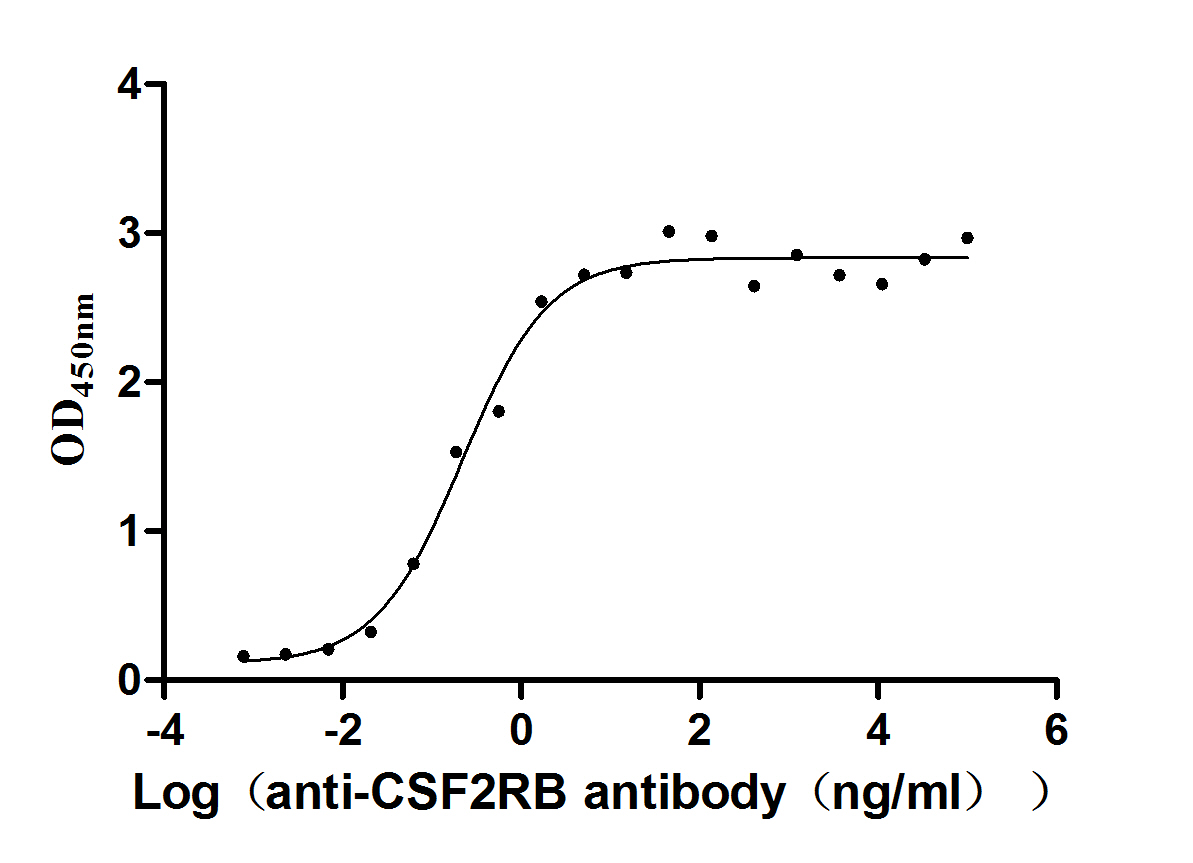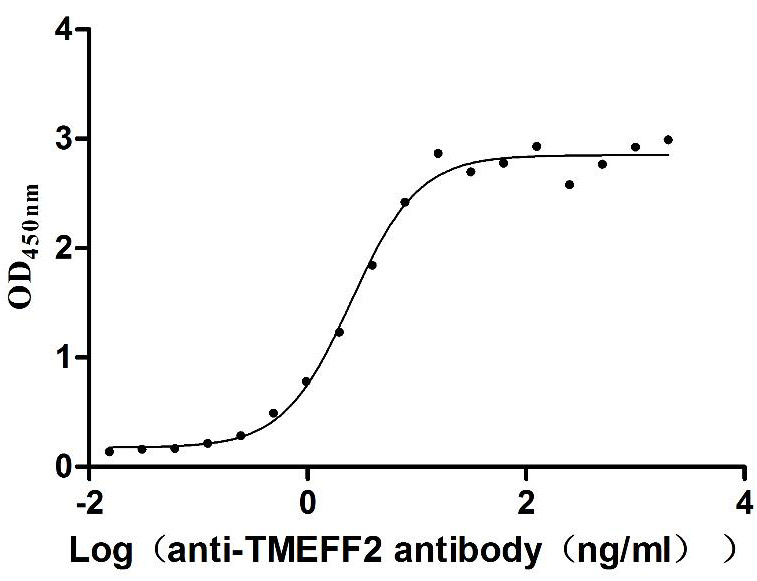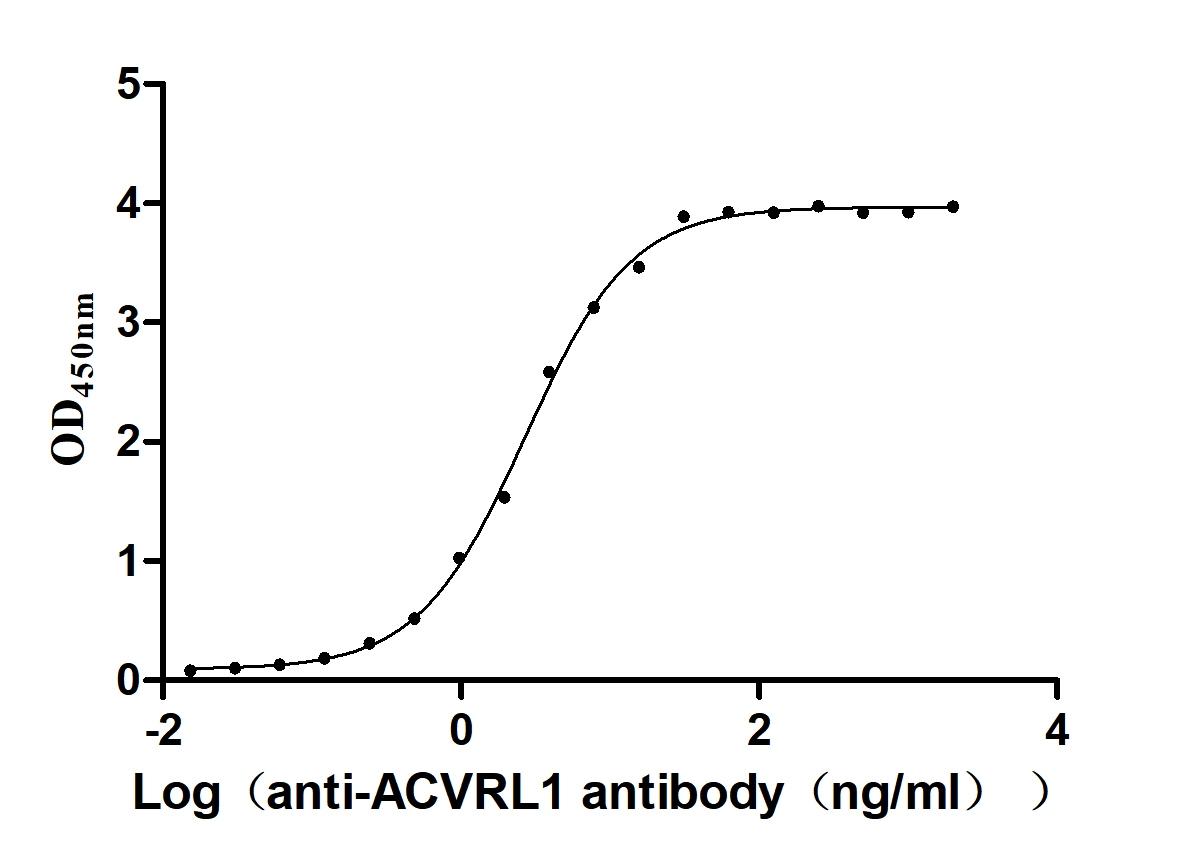Recombinant Human Oncostatin-M-specific receptor subunit beta (OSMR), partial
In Stock Promotion-
中文名稱:人OSMR重組蛋白
-
貨號:CSB-EP857869HU
-
規(guī)格:¥1536
-
促銷:
-
圖片:
-
其他:
產(chǎn)品詳情
-
純度:Greater than 85% as determined by SDS-PAGE.
-
基因名:
-
Uniprot No.:
-
別名:Interleukin-31 receptor subunit beta
-
種屬:Homo sapiens (Human)
-
蛋白長度:partial
-
來源:E.coli
-
分子量:31.3 kDa
-
表達區(qū)域:762-979aa
-
氨基酸序列KSQWIKETCYPDIPDPYKSSILSLIKFKENPHLIIMNVSDCIPDAIEVVSKPEGTKIQFLGTRKSLTETELTKPNYLYLLPTEKNHSGPGPCICFENLTYNQAASDSGSCGHVPVSPKAPSMLGLMTSPENVLKALEKNYMNSLGEIPAGETSLNYVSQLASPMFGDKDSLPTNPVEAPHCSEYKMQMAVSLRLALPPPTENSSLSSITLLDPGEHYC
Note: The complete sequence including tag sequence, target protein sequence and linker sequence could be provided upon request. -
蛋白標簽:N-terminal 10xHis-tagged and C-terminal Myc-tagged
-
產(chǎn)品提供形式:Liquid or Lyophilized powder
Note: We will preferentially ship the format that we have in stock, however, if you have any special requirement for the format, please remark your requirement when placing the order, we will prepare according to your demand. -
緩沖液:If the delivery form is liquid, the default storage buffer is Tris/PBS-based buffer, 5%-50% glycerol. If the delivery form is lyophilized powder, the buffer before lyophilization is Tris/PBS-based buffer, 6% Trehalose.
-
復(fù)溶:We recommend that this vial be briefly centrifuged prior to opening to bring the contents to the bottom. Please reconstitute protein in deionized sterile water to a concentration of 0.1-1.0 mg/mL.We recommend to add 5-50% of glycerol (final concentration) and aliquot for long-term storage at -20°C/-80°C. Our default final concentration of glycerol is 50%. Customers could use it as reference.
-
儲存條件:Store at -20°C/-80°C upon receipt, aliquoting is necessary for mutiple use. Avoid repeated freeze-thaw cycles.
-
保質(zhì)期:The shelf life is related to many factors, storage state, buffer ingredients, storage temperature and the stability of the protein itself.
Generally, the shelf life of liquid form is 6 months at -20°C/-80°C. The shelf life of lyophilized form is 12 months at -20°C/-80°C. -
貨期:3-7 business days
-
注意事項:Repeated freezing and thawing is not recommended. Store working aliquots at 4°C for up to one week.
-
Datasheet & COA:Please contact us to get it.
相關(guān)產(chǎn)品
靶點詳情
-
功能:Associates with IL31RA to form the IL31 receptor. Binds IL31 to activate STAT3 and possibly STAT1 and STAT5. Capable of transducing OSM-specific signaling events.
-
基因功能參考文獻:
- Polymorphisms of the OSMR rs2292016 locus are related to the development and outcome of DCM. PMID: 29652994
- Missense mutatios were found in exon 10 of the oncostatin-M specific receptor beta subunit (OSMR) gene in all of the six patients from family 1, and in exon 14 of the OSMR gene in all of the four patients from family 2. PMID: 29419851
- The PLAC1 expression has been demonstrated for the first time in cervical cancers. This preliminary study has further revealed a complex relationship between PLAC1 expression, cervical cancer histologic type, p53, and HPV type that requires further investigation. PMID: 28375929
- OSMR-beta deficiency in macrophages improved high-fat diet-induced atherogenesis and plaque vulnerability PMID: 28258089
- OSM and OSMR are highly expressed in inflammatory bowel disease intestinal mucosa compared to control mucosa. Intestinal stromal cells express abundant OSMR. PMID: 28368383
- OSM:OSMR interactions are able to induce EMT, increased cancer stem cell-like properties and enhanced lung colonisation in SCC cells PMID: 27351213
- the RET p.S891A mutation combined with OSMR p.G513D may underlie a novel phenotype manifesting as familial medullary thyroid carcinoma and cutaneous amyloidosis PMID: 26356818
- this study offers new findings on the molecular genetics and disease relevance of mutations in OSMR in Familial primary localized cutaneous amyloidosis. PMID: 25792357
- Oncostatin M and interleukin-31: Cytokines, receptors, signal transduction and physiology. PMID: 26198770
- OSMRBeta in neurons is critical for neuronal survival during cerebral ischemic/reperfusion. PMID: 26311783
- primary localized cutaneous amyloidosis has a missense mutation in oncostatin M receptor beta PMID: 25054142
- The interleukin IL-31/IL-31receptor axis contributes to tumor growth in human follicular lymphoma. PMID: 25283844
- oncostatin M is a cytokine possessing vigorous antiviral and immunostimulatory properties which is released by APC upon interaction with CD40L present on activated CD4+ T cells. PMID: 24418171
- The disease severity of rheumatoid arthritis and systemic lupus erythematosus can be partially affected by the OSMR promoter polymorphisms. PMID: 24219225
- We conclude that an OSMR/TGM2/integrin-alpha5beta1/fibronectin pathway is of biological significance in cervical squamous cell carcinoma PMID: 23765377
- A unique loop structure in oncostatin M determines binding affinity toward oncostatin M receptor and leukemia inhibitory factor receptor. PMID: 22829597
- enhanced production by beta-defensin-2 in T cells PMID: 22137028
- This study identified a new heterozygous OSMR missense mutation in primary localized cutaneous amyloidosis. PMID: 22062952
- An alternatively spliced variant of OSMR transcribing a soluble form of this receptor has been characterized in esophageal squamous cell carcinoma. PMID: 21394648
- We conclude that OSMR overexpression in cervical SCC cells provides increased sensitivity to OSM, which induces pro-malignant changes. PMID: 21952923
- Aberrant methylation of the OSMR gene is associated with non-invasive colorectal cancer. PMID: 21508378
- Two new pathogenic heterozygous missense mutations in the OSMR gene (p.Val631Leu and p.Asp647Tyr) were identified in two Dutch familial primary localized cutaneous amyloidosis families. PMID: 20507362
- study provides evidence for the existence of a novel pathogenic mutation in the OSMR gene in a caucasian family with familial primary cutaneous amyloidosis PMID: 19466957
- The identification of OSMR and IL31RA gene pathology provides an explanation of the high prevalence of primary cutaneous amyloidosis in Taiwan as well as new insight into disease pathophysiology. PMID: 19690585
- provides a biologic rationale for silencing of OSMR in colon cancer progression and highlight a new therapeutic target. Moreover, detection and quantification of OSMR promoter methylation in fecal DNA is a highly specific diagnostic biomarker for CRC PMID: 19662090
- expression and evidence for STAT3 activation in human ovarian carcinomas PMID: 12061840
- The expression of OSM and its receptor in ovarian tissue from fetuses and women suggests a possible role of OSM in growth initiation of human primordial follicles. PMID: 15831292
- sOSMR is able to bind OSM and interleukin-31 when associated to soluble gp130 or soluble interleukin-31R, respectively, and to neutralize both cytokine properties PMID: 17028186
- FPLCA has been mapped to 5p13.1-q11.2, and by candidate gene analysis, study identified missense mutations in the OSMR gene, encoding oncostatin M-specific receptor beta (OSMRbeta), in three families. PMID: 18179886
- murine OSMR initiates STAT5 activation directly via the receptor bound Janus kinases. Intriguingly, the murine receptor preferentially recruits JAK2, whereas the human receptor seems to have a higher affinity for JAK1. PMID: 18430728
- IL-6 and Oncostatin M individually affect the profile of leukocyte trafficking PMID: 18641356
- The renal parenchyma is capable of generating a strong acute phase response, likely mediated via OSM/OSMR. PMID: 19158344
- Epigenetic silencing and DNA methylation of OSMR is associated with colorectal cancers. PMID: 19223499
- study reporta a Japanese family with familial primary localized cutaneous amyloidosis in whom a novel OSMR mutation was observed PMID: 19375894
顯示更多
收起更多
-
相關(guān)疾病:Amyloidosis, primary localized cutaneous, 1 (PLCA1)
-
亞細胞定位:Membrane; Single-pass type I membrane protein.
-
蛋白家族:Type I cytokine receptor family, Type 2 subfamily
-
組織特異性:Expressed in keratinocytes (at protein level). Expressed at relatively high levels in all neural cells as well as fibroblast and epithelial cells.
-
數(shù)據(jù)庫鏈接:
Most popular with customers
-
Recombinant Human Cytokine receptor common subunit beta (CSF2RB), partial (Active)
Express system: Mammalian cell
Species: Homo sapiens (Human)
-
Recombinant Human Claudin-6 (CLDN6)-VLPs, Fluorescent (Active)
Express system: Mammalian cell
Species: Homo sapiens (Human)
-
Recombinant Human Tomoregulin-2 (TMEFF2), partial (Active)
Express system: Mammalian cell
Species: Homo sapiens (Human)
-
Recombinant Human CUB domain-containing protein 1 (CDCP1), partial (Active)
Express system: Mammalian cell
Species: Homo sapiens (Human)
-
Recombinant Human Serine/threonine-protein kinase receptor R3 (ACVRL1), partial (Active)
Express system: Baculovirus
Species: Homo sapiens (Human)





f4-AC1.jpg)













